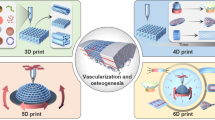Abstract
In recent years, with the development of biological 3D printing technology, especially the development of soft tissue engineering, new hope has been brought to solve clinical problems such as soft tissue defects and functional loss. The blood vessels network is essential in large pieces of tissue because blood can nourish the ambient cells proliferation and metabolism. Currently, most bio-printing technologies can only print single-size micro-channels, which affect the normal proliferation and metabolism of internal cells. In our previous study, a multi-level and multi-size bionic vascular network was molded by mould. The bionic structure could promote cells endothelialization but the preparation process was complex and the precision was very low. In this paper, a 3D vascular network/soft tissue and multi-material dual-nozzle cells printing platform is developed and then, a FDM 3D collaborative printing method is proposed to fabricate self-assembled scaffold within multi-level and multi-size bionic vascular network. The forming process is fast and sterile with the high-precision self-assembled scaffold structure printed. It is envisioned that this technology can be used to study the basis of composite tissue technology with multi-material supply and multi-nozzle printing, and to establish the theoretical basis of the correlation between vascular/soft tissue symbiosis system and the performance of artificial soft tissue.
Access this chapter
Tax calculation will be finalised at checkout
Purchases are for personal use only
Similar content being viewed by others
References
Dong, G., Lian, Q., Yang, L., et al.: Preparation and endothelialization of multi-level vessel-like network in enzymated gelatin scaffolds. J. Bionic Eng. 15(4), 673–681 (2018)
Dong, G., Lian, Q., Yang, L., et al.: Design and fabrication of vascular network for muscle tissue engineering. In: The 6th International Conference on Advanced Engineering Materials and Technology (IFEESD), vol. 75, pp. 613–621 (2016)
Qi, F., Wu, J., Li, H., et al.: Recent research and development of PLGA/PLA microspheres/nanoparticles: a review in scientific and industrial aspects. Front. Chem. Sci. Eng. 13(1), 14–27 (2019)
Sherman, T.F.: On connecting large vessels to small. The meaning of Murray’s law. J. Gen. Physiol. 78(4), 431–453 (1981)
Liu, Z., Ma, R., Zhang, T., et al.: Effects of blood flow in y-type bifurcated coronary arteries on thrombosis. J. Bei**g Univ. Technol. 36(9), 1153–1158 (2010)
Liu, B., You, Q., Hu, G., et al.: The construction of small type bionic artificial stent and mechanics research in vitro. Chin. Exp. Surg. 26(5), 567–569 (2009)
Mao, W., Lian, Q., Li, D., et al.: 3D printing technology of three-dimensional hollow blood tube network hydrogel scaffold. J. Mech. Eng. (9) (2017)
Yang, T., Wen, J., Ren, S., et al.: Clinical observation on the establishment of 29 ACUSEAL artificial arteriovenous internal fistula. Chin. J. Blood Purif. (2018)
Kelch, I.D., Bogle, G., Sands, G.B., et al.: Organ-wide 3D-imaging and topological analysis of the continuous microvascular network in a murine lymph node. Sci. Rep. 5, 16534 (2015)
Bankir, L.: Renal vascularization: organization of the capillaries of the floculus. Post-glomerular irrigation. Journal Durologie Et De Néphrologie 82(9), 721–726 (1976)
Author information
Authors and Affiliations
Corresponding author
Editor information
Editors and Affiliations
Rights and permissions
Copyright information
© 2020 Science Press
About this paper
Cite this paper
Dong, G., Hu, Y., Huyan, Y., Zhang, W., Yang, C., Da, L. (2020). 3D-Printing of Scaffold Within Bionic Vascular Network Applicable to Tissue Engineering. In: Duan, B., Umeda, K., Hwang, W. (eds) Proceedings of the Seventh Asia International Symposium on Mechatronics. Lecture Notes in Electrical Engineering, vol 588. Springer, Singapore. https://doi.org/10.1007/978-981-32-9437-0_94
Download citation
DOI: https://doi.org/10.1007/978-981-32-9437-0_94
Published:
Publisher Name: Springer, Singapore
Print ISBN: 978-981-32-9436-3
Online ISBN: 978-981-32-9437-0
eBook Packages: Intelligent Technologies and RoboticsIntelligent Technologies and Robotics (R0)




